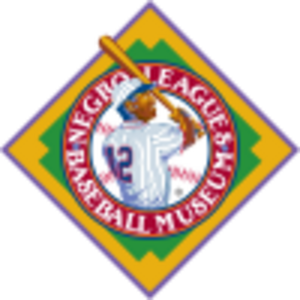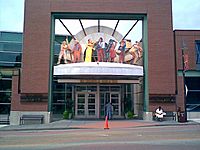Negro Leagues Baseball Museum facts for kids
 |
|
 |
|
| Established | 1990 |
|---|---|
| Location | Kansas City, Missouri |
| Type | Professional sports |
The Negro Leagues Baseball Museum (NLBM) is a special place in Kansas City, Missouri. It helps us remember and learn about the history of Negro league baseball in America. This museum started in 1990. It's located in the historic 18th & Vine District. This area was a very important center for African-American culture in Kansas City many years ago. The NLBM shares its building with the American Jazz Museum.
Contents
The Museum's Story
The Negro Leagues Baseball Museum was started in 1990. It was founded by a group of former Negro league baseball players. These players included Alfred Surratt, Buck O'Neil, Larry Lester, Phil S. Dixon, and Horace Peterson.
Growing the Museum
The museum began in a small, single room. This room was inside the Lincoln Building on 18th & Vine Streets. In 1994, it moved to a much larger space. This new area was about 2,000 square feet. Just three years later, in 1997, the museum moved again. It went into a special building built just for it. This new home was 10,000 square feet, five times bigger than before!
A Movie Helps the Museum
On April 11, 2013, a special showing of the movie 42 happened in Kansas City. This movie is about the life of Jackie Robinson. Jackie Robinson played for the Kansas City Monarchs. He was the first African-American player to break the color barrier in Major League Baseball. This special movie showing helped raise money for the NLBM. The actor Harrison Ford, who was in the film, also helped with this event.
Overcoming Challenges
In 2008, the museum faced some money problems. But it got stronger with new leaders and more help from the community. Bob Kendrick became the President in 2011. By 2012, the museum was doing very well. It made a profit of $300,000. This was its best year since 2007. In June 2019, the museum won a big award. It received the Gold American Award for Nonprofit Organization of the Year. This award came from the American Business Awards.
Exploring the Exhibits
The museum shows the history of the Negro leagues in order. It has signs with information and interactive displays. The walls are covered with pictures of players, owners, and officials. These pictures are from the Negro National League (1920) to the Negro American League (which lasted until 1962). As you walk through, you move forward in time.
Player Lockers and Gear
In one part of the museum, there are lockers set up. These lockers belong to some of the famous Negro league players. You can see uniforms they wore in games. You can also see their cleats, gloves, and other items. These items belonged to stars like Josh Gibson. He was sometimes called the "Black Babe Ruth."
The Field of Legends
A very cool part of the museum is the Field of Legends. You can only walk onto this field at the end of your visit. It has nearly life-sized bronze statues of twelve important figures from Negro league history.
- Behind home plate is Josh Gibson. He was one of the best hitters ever. People say he hit over 80 home runs in one season!
- At first base is another Baseball Hall of Famer, Buck Leonard. He played with Gibson on the Homestead Grays.
- At second base is John Henry Lloyd.
- Judy Johnson is at shortstop.
- Ray Dandridge plays third base.
- In the outfield, you'll find Cool Papa Bell, Oscar Charleston, and Leon Day.
- On the pitcher's mound is Satchel Paige. He is perhaps the most famous Negro leaguer. He became a rookie in the major leagues at age 42 in 1948.
- At the plate is Martín Dihigo. He is the only player in the Halls of Fame in three countries: Mexico, Cuba, and the United States.
- Other statues honor Rube Foster. He started the first Negro National League.
- There's also a statue of Buck O'Neil. He was a former Kansas City Monarch. He was also on the museum's board until he passed away on October 6, 2006.
Buck O'Neil's Special Items
On November 13, 2012, Buck O'Neil's family gave two special items to the museum. This was to honor what would have been his 101st birthday. They donated O'Neil's Presidential Medal of Freedom. This award was given to him after he passed away by President George W. Bush. They also gave a small copy of the Buck O'Neil statue. The original statue is at the National Baseball Hall of Fame and Museum. These items are shown in a special area of the NLBM dedicated to Buck O'Neil.
The Geddy Lee Collection
On June 5, 2008, Geddy Lee made a big donation. He is from the Canadian band Rush and loves baseball. He gave nearly 200 baseballs with autographs to the NLBM. These baseballs have signatures from famous people like Hank Aaron, Cool Papa Bell, and Lionel Hampton. At that time, Geddy Lee's gift was one of the largest donations the museum had ever received.
Awards Given by the Museum
Each year, the museum gives out several important awards:
- Oscar Charleston Legacy Award – This award goes to the "Most Valuable Players" in the National (NL) and American (AL) leagues.
- Pitcher of the Year – This award honors the best "Pitchers of the Year" in the NL and AL.
- Leroy "Satchel" Paige Legacy Award (2000–2005)
- Wilbur "Bullet" Rogan Legacy Award (2006–present)
- Larry Doby Legacy Award – This award is for the "Rookies of the Year" in the NL and AL.
- Hilton Smith Legacy Award – This award recognizes the "Relievers of the Year" in the NL and AL.
- Walter "Buck" Leonard Legacy Award – This award is for the batting champions in the NL and AL.
- Josh Gibson Legacy Award – This award goes to the "Home Run" leaders in the NL and AL.
- James "Cool Papa" Bell Legacy Award – This award is for the "Stolen Base" leaders in the NL and AL.
- Charles Isham "C. I." Taylor Legacy Award – This award honors the "Managers of the Year" in the NL and AL.
- Andrew "Rube" Foster Legacy Award – This award is for the "Executives of the Year" in the NL and AL.
- John Henry "Pop" Lloyd Legacy Award – This award recognizes "Baseball and Community Leadership."
- Sam Lacy Legacy Award – This award is for the "Baseball Writer of the Year."
- Jackie Robinson Lifetime Achievement Award – This award celebrates "Career Excellence in the Face of Adversity."
- John "Buck" O'Neil Legacy Award – This award is given to a company or person for "Outstanding Support of the NLBM."
- Hall of Game Award – This award honors former Major League Baseball stars.
See also

